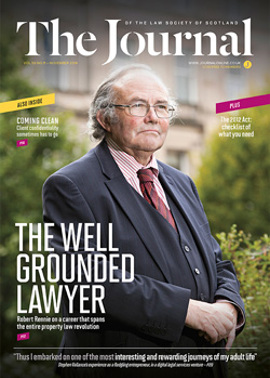Equal pay: a professional imperative

To get involved in the Society’s equality and diversity work, see the website www.lawscot.org.uk/diversity or contact diversity@lawscot.org.uk In early January the Society launched its new three-year Equality and Diversity Strategy.
Covering the period from November 2014 to October 2017, this third version of the strategy (www.lawscot.org.uk/about-us/equality-and-diversity/the-society/our-strategy) is revised and updated, taking account of the Society’s activities since the last edition as well as legal developments during the period. Among other things, it is designed to ensure that equality and diversity considerations are taken into account in all the Society’s decision making, and that the Society promotes best practice in relation to equality and diversity to the solicitors’ profession and to the Society’s stakeholders, and promotes understanding between different groups.
Detailed development work for the new strategy took place over 2013 and 2014, and a model was prepared for a consultation which took place over an extended period last summer and autumn, completing in October 2014.
We asked about both a simple set of core standards likely to drive improvements in key areas identified, and a more detailed framework to assist firms that want to demonstrate their ongoing commitment, which we are now developing further. In addition, we commissioned specific interviews with 13 legal employers or organisations and 12 equality bodies, to gain detailed input to the proposals. The open consultation, which was publicised widely to the profession through the Journal and Society bulletin, received a number of responses from firms and individuals. Overall support for the proposals was very positive.
Equality indicators
With work continuing at pace, this month has seen the introduction of 10 new equality standards for legal organisations (see separate box), along with a supporting guide on one key element – how to undertake an equal pay audit.
Many areas have improved across the legal profession following a decade of research and work by the Society, but the new, and currently voluntary, standards focus on those key areas where little progress has been made.
Janet Hood, convener of the Society’s Equality & Diversity Committee, points out the benefits of introducing specific equality standards:
“Employers already have legal responsibilities in relation to equality, and we hope these standards clarify what might be key issues in the legal sector. We also think it will mean that firms can benefit from employees and clients, current and prospective, seeing them as leading in this field.
“In addition to introducing the new standards, the committee was keen to continue our series of supportive guides on equality issues to help firms, large and small, address issues which show in the research, with the focus this time on equal pay as we can still see a gender pay gap within the profession.”
On the specific issue of equal pay, the message from the committee is robust. As Hood sums up: “After a decade of Society guidance and 45 years of equal pay legislation, there is still a gender pay gap of up to 42% visible in the profession. As a profession, we cannot ignore that, and that is why we want to provide information and support to employers to enable them to reflect on the issue and what factors might be at play in their businesses.”
She points out that with 56% of all solicitors, and 69% of female solicitors, under the age of 45, more women than ever are choosing to become solicitors, “so it is essential for us to continue to address equality issues to ensure that both men and women who can and want to progress in their legal careers, can do so”.
Rule on the way?
The Society is making clear to members that, while the equality standards are voluntary at present, within the next year these may move to the more formal status of “guidance” (which is considered when a complaint is made), and indeed after three years may become a rule.
Why is this work important? We have seen massive progress in the profession in relation to equality, which is great; however the Society needs to be aware of its duties under the Equality Act 2010 and the Legal Services (Scotland) Act 2010.
Where factors have not improved over the past 10 years, we need to act. We hope that further voluntary clarification will assist law firms and other organisations of all sizes which employ solicitors. We also hope that we will get feedback from organisations about how the new standards work in practice. Firms that adopt early will have the advantage of knowing they are well prepared when these requirements become more formal.
Empowering individuals
The Society has now undertaken a decade of research on equality, including three profession-wide surveys which have generated the largest number of responses for any of the Society’s member research, with around 3,000 for each survey. Detailed focus groups, and the examination of other professions and jurisdictions, have also formed part of the evidence base. In addition, we have participated in joint research projects, with the Judicial Appointments Board for Scotland and other justice bodies, around access to legal services. From this, we could see that there was strong support for developing a more prescriptive set of standards to complement the supportive guides on equality that had already been published.
Regarding the equal pay audit, Hood comments: “We want to empower individuals with information which will let them ask their employers if they can guarantee that equal pay is being delivered. It’s hard to provide assurance on this without some form of equal pay audit, so we made the decision to provide specific guidance to firms on how to do this. We would be delighted to work with a small number of firms on implementing the approach to create case studies for the profession, so would encourage firms to get in touch.
“It will be very interesting to monitor the impact this has and what change we may see as a result.”
THE 10 EQUALITY STANDARDS
Every law firm, licensed provider or legal team within an employing organisation (ìan organisationî) must, in a manner appropriate to its services and proportionate to its size, ensure that:
Leadership
1. There is a named ìequality leadî, who is responsible for ensuring these guidance objectives are met and, as appropriate, for reviewing the results of any equality monitoring.
Strategy
2. There is an equality strategy for staff and delivery of client services which is reviewed annually.
3. Measurable objectives are set in the equality strategy for both staff and delivery of client services, and these are reviewed annually.
4. The equality strategy is informed by monitoring of the workforce with reference to the protected characteristics in a way that is appropriate and relevant to the size of the practice or organisation.
Staff development
5. There is a training plan for all staff on equality and diversity.
Reporting and publication
6. The equality strategy and annual updates on the measurable objectives are available to staff, clients, prospective clients and the Society.
7. A separate statement is made annually about the composition of organisational roles with reference to the protected characteristics, with reporting of sex as a minimum.
Equal pay
8. There is a statement on equal pay which is available to staff, clients, prospective clients and the Society.
9. If it is an organisation with more than 150 employees, its gender pay gap figures are published for full time and part time staff at each level of seniority.
Accessible services
10. It is responsive to the legal needs of a wide range of diverse communities, and in particular, has a single document available to the public which contains information on accessibility options for disabled and other service users.
To get involved in the Society’s equality and diversity work, see the website www.lawscot.org.uk/diversity or contact diversity@lawscot.org.uk
In this issue
- Supreme Courts: the US and UK compared
- Taking farmers to market
- Queuing up for Street Law
- Cash for your body
- Ivor Guild: an appreciation
- Reading for pleasure
- Journal magazine index 2014
- Opinion: Waqqas Ashraf
- Book reviews
- Profile
- President's column
- More benefits from development plan approval
- People on the move
- On track for 1 April
- In five years' time...
- Glasgow 2015: the three Rs
- Powers of attorney: the Inner House decides
- Freelancing goes mainstream
- Socially acceptable?
- Searching questions
- Separation and the stored embryo
- Effect, not cause: is obesity a disability?
- Goodbye to the Lamborghini?
- Scottish Solicitors Discipline Tribunal
- The dispute resolvers
- Take care with Lender Exchange
- Law reform roundup
- From the Brussels office
- Equal pay: a professional imperative
- Are you a cyber risk?
- Ask Ash
- Property in the spotlight
- Sweet smell of added value
- Legally IT: the evolving lawyer






